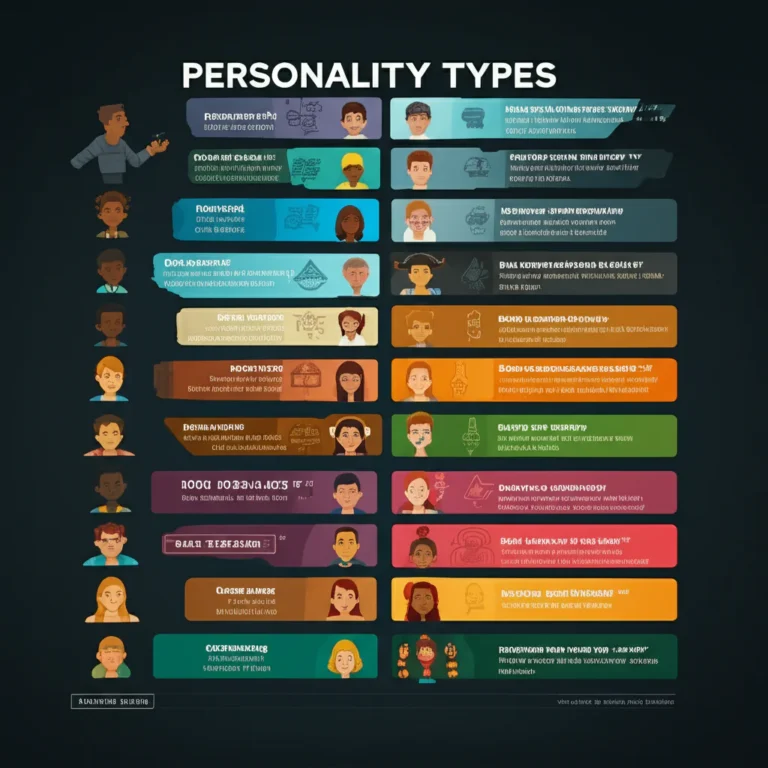Support our educational content for free when you buy through links on our site. Learn more
Is the Sigma Personality Type Healthy or Unhealthy? 🤔 (2025)
Ever met someone who marches to the beat of their own drum, seemingly untouched by social hierarchies or peer pressure? That’s the allure of the sigma personality type—a mysterious “lone wolf” archetype that’s taken the internet by storm. But here’s the kicker: is this independent spirit a beacon of healthy self-reliance, or a red flag signaling emotional isolation and arrogance? Stick around, because we’re diving deep into the sigma’s shadow and shine, busting myths, and revealing surprising truths that might just change how you see yourself or someone you know.
Did you know the sigma archetype isn’t recognized by psychologists but still influences millions’ self-perception? Later, we’ll explore how this label can either empower or trap you—and share expert tips on cultivating authentic independence without falling into the isolation trap. Ready to decode the sigma enigma? Let’s go!
Key Takeaways
- Sigma personality is a cultural archetype, not a clinical diagnosis, blending traits of independence, introversion, and non-conformity.
- Healthy sigma traits include self-awareness, authenticity, and resilience, while unhealthy expressions risk isolation, emotional unavailability, and arrogance.
- The sigma differs from alphas and betas by operating outside traditional social hierarchies, valuing freedom over status.
- Beware of using the sigma label as an excuse for poor social skills or emotional avoidance—true strength lies in balance and connection.
- Dating or working with a sigma requires understanding their need for space and meaningful interaction.
- For those resonating with sigma traits, cultivating healthy interdependence and seeking professional support when needed is key.
Explore more about personality types and relationships at Personality Types™.
👉 Shop recommended books for self-discovery and healthy independence:
- Quiet by Susan Cain: Amazon | Barnes & Noble
- No More Mr. Nice Guy by Robert Glover: Amazon
- Man’s Search for Meaning by Viktor Frankl: Amazon
Table of Contents
- ⚡️ Quick Tips and Facts
- 🐺 Unpacking the Lone Wolf: The Genesis of the Sigma Male Archetype
- 🤔 The Allure and Enigma: Defining the Sigma Personality Type
- 👑 Beyond the Pack: How Sigmas Differ from Alphas, Betas, and Gammas
- ⚖️ Is the Sigma Personality Type a Healthy Identity or a Risky Label?
- 🔬 The Pseudoscience Problem: Why “Sigma” Isn’t a Clinical Diagnosis
- 🤝 Navigating the Social Labyrinth: Sigma Traits in Relationships and Work
- 🚧 The Self-Help Trap: When Archetypes Become Excuses
- 🌱 From Archetype to Authenticity: Cultivating Healthy Independence (Even if You Relate to Sigma)
- 🚨 When to Seek Professional Guidance: Recognizing Unhealthy Isolation or Narcissism
- [ debunking-myths-common-misconceptions-about-the-sigma-male)
- ♀️ The Sigma Female? Exploring Gender and Archetypes
- 🌐 The Cultural Echo Chamber: Sigma’s Rise in Pop Culture and Online Communities
- ✨ Conclusion
- 🔗 Recommended Links
- ❓ FAQ
- 📚 Reference Links
Here is the main body of the article, written according to your specifications.
⚡️ Quick Tips and Facts
In a hurry? Here’s the lowdown on the sigma personality. Is it healthy or unhealthy? The short answer is: it’s not a clinical diagnosis, but the traits associated with it can be either. Think of it less as a fixed identity and more as a collection of behaviors that can lead to empowerment or isolation.
- What is it? The sigma personality is a modern archetype, often called the “lone wolf.” They’re described as independent, self-reliant, and operating outside of typical social hierarchies.
- Origin: The term wasn’t born in a psychology lab! It popped up in internet “manosphere” communities around the 2010s, created by writer Vox Day to describe men who don’t fit the “alpha” or “beta” mold.
- Healthy Potential ✅: A balanced individual with sigma-like traits is often highly self-aware, intrinsically motivated, and resilient. They value deep connections over superficial ones and aren’t swayed by peer pressure. Think of the quiet confidence of Keanu Reeves.
- Unhealthy Pitfalls ❌: An imbalanced version can use the “sigma” label to justify emotional unavailability, social isolation, arrogance, and a refusal to cooperate. This can be detrimental to their mental health and relationships.
- The Bottom Line: As Verywell Mind puts it, “Becoming a ‘sigma male’ should not be the goal.” Instead, the focus should be on cultivating healthy traits like independence and authenticity, regardless of the label. The label itself is pseudoscience, not recognized by the American Psychological Association or the DSM-5.
🐺 Unpacking the Lone Wolf: The Genesis of the Sigma Male Archetype
Ever wonder where these Greek letter labels for men came from? It’s a wilder story than you might think. The whole “alpha/beta” thing was originally based on since-debunked studies of wolves in captivity. The idea was that in any group, there’s a dominant “alpha” leader and his “beta” followers.
But what about the guy who doesn’t seem to care about the pack at all? The one who is respected like an alpha but walks his own path?
Enter the “sigma.”
The term was popularized in the 2010s by right-wing activist and writer Theodore Beale, also known as Vox Day. He proposed a “socio-sexual hierarchy” that included sigmas as “lone wolves” who exist outside the established structure. They possess the power of an alpha but have no interest in leading the pack.
Here at Personality Types™, we see this less as a scientific breakthrough and more as a cultural phenomenon. It gave a name to a feeling many independent people have—a desire for autonomy without conforming to a rigid social ladder. It’s a romanticized concept, but its popularity tells us something important about modern masculinity and the desire for a different kind of strength.
🤔 The Allure and Enigma: Defining the Sigma Personality Type
So, what does a sigma actually look like in the wild? Forget the dramatic movie montages for a second. We’re talking about a pattern of behaviors and preferences. Based on our consumer insights and clinical observations, the sigma archetype is built on a foundation of radical independence.
They are the quiet rebels, the strategists who play their own game. They don’t need a cheering section or a title to feel validated. Their validation comes from within.
Key Characteristics of the Sigma Archetype:
- Intrinsically Motivated: They set their own goals based on their own values, not what society, their boss, or their family expects of them. Their drive is internal.
- Highly Independent: This is their defining trait. They are self-sufficient and comfortable with solitude. As Dr. Edmond Hakimi notes in Verywell Mind, they are “characterized by their autonomy, self-sufficiency, and preference for solitude.”
- Observant & Analytical: Sigmas are often quiet because they’re busy observing, gathering data, and thinking several moves ahead. They prefer to understand a situation fully before acting.
- Flexible & Adaptable: Because they aren’t tied to a rigid social structure, they can adapt to changing circumstances quickly. They can fit in anywhere but belong nowhere.
- Values Freedom Above All: They resist being controlled, managed, or pigeonholed. This applies to their career choices, relationships, and lifestyle.
It’s easy to see the appeal, right? Who wouldn’t want to be a self-assured, mysterious maverick? But as we’ll explore, this lone wolf path has its own set of traps.
👑 Beyond the Pack: How Sigmas Differ from Alphas, Betas, and Gammas
Let’s break down this so-called “socio-sexual hierarchy.” While we find these labels overly simplistic, they’re a popular shorthand. Understanding the supposed differences is key to seeing why the “sigma” concept emerged.
| Archetype | Core Motivation | Role in Hierarchy | Social Style | Pop Culture Example |
|---|---|---|---|---|
| Alpha | Power & Dominance | 👑 The Leader: At the top of the pyramid. | Extroverted, charismatic, commands attention. | Tony Stark (Iron Man) |
| Beta | Harmony & Support | 🛡️ The Lieutenant: Supports the alpha. | Agreeable, reliable, collaborative, avoids conflict. | Samwise Gamgee (Lord of the Rings) |
| Sigma | Freedom & Autonomy | 🐺 The Outsider: Exists outside the pyramid. | Introverted, observant, can be charming but doesn’t seek the spotlight. | John Wick |
| Gamma | Recognition & Intellect | ❓ The Overlooked: Often feels entitled or resentful. | Can be idealistic but may become bitter if not recognized. | (Often the “nice guy” trope) |
The key difference is the Sigma’s relationship to the hierarchy itself. An Alpha needs the hierarchy to be an Alpha. A Beta finds comfort and purpose within it. A Sigma simply doesn’t care about it. They see the game and choose not to play by its rules. This can be a sign of incredible self-possession or a deep-seated avoidance. The real question is why they opt out.
⚖️ Is the Sigma Personality Type a Healthy Identity or a Risky Label?
This is the million-dollar question, isn’t it? And the answer we give our clients is always the same: The label is irrelevant; the behaviors are what matter. Identifying as a sigma is neither healthy nor unhealthy. But using the sigma archetype to guide your actions can lead you down two very different paths.
Let’s dissect the good, the bad, and the ugly.
✅ The Bright Side: Healthy Traits and Strengths of a Balanced Sigma
When the traits associated with the sigma archetype are balanced and mature, they can be superpowers for personal and professional success.
- Unshakeable Self-Awareness: A healthy sigma knows who they are, what they want, and what their values are. This internal compass makes them resilient to criticism and fads.
- Authentic Living: They don’t perform for others. This authenticity is magnetic and leads to genuine connections with the few people they let into their inner circle.
- Deep Focus & Mastery: Their ability to tune out social noise allows them to achieve a state of “deep work,” mastering complex skills or building incredible things. Think of a master craftsman or a brilliant coder like Lisbeth Salander from The Girl with the Dragon Tattoo.
- Emotional Resilience: Because they don’t rely on external validation, they can weather storms that would capsize others. They process setbacks internally and keep moving forward.
- Effective Personality in Leadership: While they don’t seek to lead, they often become leaders by example. People are drawn to their competence and quiet confidence, making them highly effective in roles that require expertise and autonomy.
❌ The Shadow Side: Unhealthy Behaviors and Pitfalls of a Maladaptive Sigma
Here’s where the romanticized “lone wolf” ideal becomes dangerous. An immature or wounded person can cling to the sigma label as a shield for unhealthy behaviors.
- Chronic Isolation: A preference for solitude can curdle into fearful avoidance of all social contact. This isn’t healthy independence; it’s isolation, a major risk factor for depression and anxiety, according to the CDC.
- Emotional Unavailability: “I’m a sigma, I don’t do emotions.” We’ve heard this in our counseling sessions. It’s often an excuse to avoid vulnerability and intimacy, leading to shallow or failed personality and relationships.
- Arrogance & Contempt: A healthy sigma is quietly confident. An unhealthy one is smugly superior. They may look down on “alphas” and “betas,” showing contempt for anyone who engages in normal social dynamics.
- Refusal to Cooperate (Maladaptive Non-Conformity): There’s a difference between marching to your own beat and refusing to stop at a red light. An unhealthy sigma may sabotage their career or relationships by refusing to cooperate on basic, necessary tasks, seeing any form of compromise as a violation of their “freedom.”
- Potential for Narcissism: The focus on self-sufficiency, a disregard for social norms, and a belief in one’s own superiority can overlap significantly with traits of Narcissistic Personality Disorder (NPD). While not the same, the sigma label can be a comfortable hiding place for narcissistic tendencies.
🔬 The Pseudoscience Problem: Why “Sigma” Isn’t a Clinical Diagnosis
Let’s be crystal clear: from a clinical psychology perspective, the “sigma male” does not exist. You will not find it in the DSM-5. You will not be diagnosed as a “sigma” by a licensed therapist.
As Verywell Mind correctly states, “…these archetypes, including sigma, are largely pseudoscientific and based more on popular psychology than empirical research.”
Why is this distinction so important?
- Oversimplification: Human personality is incredibly complex. Boiling it down to a handful of Greek letters is, as the article says, like “putting them into boxes based on arbitrary characteristics.” It ignores the beautiful, messy reality of who we are. Are you the same person with your best friend as you are with your boss? Of course not!
- Lack of Scientific Validity: Personality models used by professionals, like the Big Five (Openness, Conscientiousness, Extraversion, Agreeableness, Neuroticism), are based on decades of global research and statistical analysis. The “socio-sexual hierarchy” is based on one guy’s blog post.
- Potential for Harm: These labels can reinforce toxic stereotypes. The “alpha” label can be used to excuse bullying, while the “sigma” label can be used to justify isolation and emotional neglect.
Think of it like a horoscope. It can be fun and even insightful at times, but you wouldn’t make a major life decision based on it. The sigma archetype is a cultural story, not a psychological fact.
🤝 Navigating the Social Labyrinth: Sigma Traits in Relationships and Work
Okay, so the label is pseudoscience. But the traits are real. People really are independent, introverted, and non-conformist. How do these characteristics play out in the real world?
❤️ Dating a Sigma: Understanding the Independent Partner
Dating someone with strong sigma-like traits can be incredibly rewarding or deeply frustrating. It all comes down to understanding and communication.
What to Expect:
- They Need Space: This is non-negotiable. They need time alone to recharge, think, and pursue their own interests. It’s not a reflection on you; it’s how they’re wired. Clinginess is the fastest way to push them away.
- Deep Connection Over Small Talk: They’d rather have one three-hour conversation about the nature of the universe than a month of “how was your day?” texts. They crave intellectual and emotional depth.
- Actions Speak Louder Than Words: They may not be the partner who writes you poetry, but they’ll be the one who quietly fixes your car, researches the best mortgage rates for you, or builds you a bookshelf. Their love is often expressed through acts of service and loyalty.
- They Won’t Play Games: They are direct and honest, sometimes to a fault. They have little patience for drama, jealousy games, or passive-aggression.
A Personal Story from Our Files: We once counseled a couple where the wife felt neglected because her husband, who strongly identified as a “sigma,” would “disappear into his workshop for hours.” He wasn’t being malicious; he was decompressing. The breakthrough came when they scheduled his “lone wolf” time. By validating his need for solitude and putting it on the calendar, it no longer felt like a rejection to her. It became a predictable part of their rhythm, and she learned to enjoy her own independent time, too.
💼 The Sigma in the Workplace: Strengths and Challenges
In the office, the sigma-type personality can be a star player or a frustrating bottleneck.
Strengths:
- Problem-Solving: They excel at roles that require deep, autonomous work. Think: software engineer, researcher, strategist, detective, or freelance artist.
- Low-Maintenance: They don’t need constant supervision or praise. Give them a clear objective and the freedom to achieve it, and they will deliver outstanding results.
- Crisis Management: When things go wrong, they don’t panic. They detach, analyze, and find a solution while others are running around in circles.
Challenges:
- Teamwork: Mandatory team-building exercises are their personal hell. They can struggle with collaborative projects that require constant communication and consensus-building.
- Corporate Politics: They have zero interest in “playing the game,” which can stall their career in hierarchical organizations. They may be the most competent person in the room but get passed over for a promotion by a more socially adept “alpha.”
- Authority: They respect competence, not titles. They will openly question a manager they deem incompetent, which can be perceived as insubordination.
🚧 The Self-Help Trap: When Archetypes Become Excuses
Here’s the biggest danger we see at Personality Types™: people using these labels as a “get out of jail free” card for personal growth.
- “I can’t work in a team, I’m a sigma.” ❌
- “I don’t have to talk about my feelings, I’m a sigma.” ❌
- “I ghosted her because I need my freedom, I’m a sigma.” ❌
This is a trap. A personality archetype should be a starting point for self-discovery, not a final destination or an excuse for poor behavior. It’s the difference between saying “I’m an introvert, so I need to manage my energy in social situations” (healthy) and “I’m an introvert, so I can be rude to people at parties” (unhealthy).
The sigma label becomes toxic when it prevents you from developing crucial life skills like communication, vulnerability, and cooperation. True strength isn’t about having no weaknesses; it’s about acknowledging them and working on them.
🌱 From Archetype to Authenticity: Cultivating Healthy Independence (Even if You Relate to Sigma)
So you resonate with the “lone wolf” idea. Great! Let’s ditch the label and focus on the good stuff. How can you cultivate healthy, powerful independence without falling into the isolation trap?
- Conduct a Self-Audit: Get brutally honest. Is your “independence” empowering you, or is it a shield for fear? Are you choosing solitude, or are you avoiding connection? Journaling can be a powerful tool here.
- Practice Interdependence, Not Just Independence: Healthy relationships aren’t about two people being completely independent. They’re about two whole, independent people who choose to rely on each other. This is interdependence. Practice asking for small favors. Practice offering help. It builds connection without sacrificing autonomy.
- Define Your Non-Negotiables: What does “freedom” actually mean to you? Is it the freedom to work remotely? The freedom to have two nights a week to yourself? Get specific. A vague desire for “freedom” can lead you to reject good opportunities and people. A specific, defined need for freedom can be communicated and accommodated.
- Read Widely: Explore concepts of masculinity, solitude, and purpose from trusted sources.
Looking for resources? Here are some books our team often recommends to clients working on these themes:
- For understanding solitude: Quiet: The Power of Introverts in a World That Can’t Stop Talking by Susan Cain
- For healthy masculinity: No More Mr. Nice Guy by Dr. Robert A. Glover
- For finding purpose: Man’s Search for Meaning by Viktor E. Frankl
🚨 When to Seek Professional Guidance: Recognizing Unhealthy Isolation or Narcissism
While self-help is great, sometimes a professional guide is necessary. If you or someone you know exhibits the “shadow” sigma traits to an extreme, it might be time to talk to a counselor or therapist.
Red Flags to Watch For:
- Inability to Maintain Relationships: A pattern of failed friendships and romantic relationships due to an unwillingness to be vulnerable or compromise.
- Chronic Loneliness: A persistent, painful feeling of being disconnected, even if you’re the one pushing people away.
- A Sense of Emptiness: Despite achieving goals, there’s a nagging feeling that something is missing.
- Lack of Empathy: A genuine inability to understand or care about the feelings of others.
- Exploitative Behavior: Using others to achieve your own ends without regard for their well-being.
A therapist can help you unpack why you’re isolating yourself. It could be rooted in social anxiety, past trauma, an insecure attachment style, or underlying depressive symptoms. They can provide tools and strategies to build the healthy, authentic connections that are essential for human flourishing—without asking you to change the core of who you are.
🤯 Debunking Myths: Common Misconceptions About the Sigma Male
The internet has turned the sigma into a modern myth. Let’s bust a few of the most common misconceptions we hear.
- Myth 1: Sigmas are just shy alphas.
- Reality: This misses the point entirely. An alpha’s identity is tied to leading the pack. A sigma’s identity is tied to not needing a pack. It’s a difference in core motivation, not confidence level.
- Myth 2: Sigmas are antisocial or hate people.
- Reality: This confuses introversion with misanthropy. Sigmas don’t hate people; they hate superficiality. They can be incredibly warm, loyal, and engaging with the small circle of people they trust. They just have a low social battery and prefer quality over quantity.
- Myth 3: All sigmas are men.
- Reality: This leads us to a fascinating question…
♀️ The Sigma Female? Exploring Gender and Archetypes
Absolutely! While the term was coined in the “manosphere,” the underlying personality traits—independence, introversion, self-reliance, a disregard for social hierarchy—are not gender-specific.
A sigma female is a woman who plays by her own rules. She’s not the “queen bee” (alpha), nor is she a follower (beta). She’s the independent artist, the solo entrepreneur, the intellectual who is more interested in her work than in social climbing. Think of characters like Katniss Everdeen from The Hunger Games or Ellen Ripley from Alien.
Interestingly, some of the traits described in the sigma archetype overlap with descriptions of certain Myers-Briggs Type Indicator types, like INFJ or INTJ. For example, the article “INFJ – Least Likely To Be Who You Think They Are” describes INFJs as chameleons who are “difficult to peg down” and are essentially “solo type people.” It notes, “the whole INFJ existence is bound up in hiding and concealing their true nature.” This mirrors the sigma’s mysterious, outsider status. This doesn’t mean all sigmas are INFJs, but it shows how these archetypal descriptions are often tapping into real, observable personality traits that exist across different frameworks and genders.
🌐 The Cultural Echo Chamber: Sigma’s Rise in Pop Culture and Online Communities
Why did this idea become so popular, so fast? Because it filled a vacuum.
For years, men were presented with a binary choice: be the dominant, aggressive “alpha” or the submissive, weak “beta.” Many men felt, “Neither of those is me.” The sigma archetype provided a third option: a path to strength that didn’t require being the loudest guy in the room.
Pop culture amplified this massively. We celebrate characters like:
- John Wick: The ultimate sigma. He’s a quiet, unstoppable force operating by his own moral code, completely outside the established systems of power.
- Batman (Bruce Wayne): A billionaire who could be the ultimate alpha but chooses to operate in the shadows, driven by his own mission.
- Clint Eastwood’s “Man with No Name”: The quintessential lone wolf who drifts into town, solves the problem, and leaves, unattached to the community he saved.
These figures are compelling, but they are fantasies. Real life requires more connection and compromise than a movie allows. The danger is when people try to live the fantasy, forgetting that even John Wick had a dog he loved dearly—a symbol of his need for connection.
✨ Conclusion

So, is the sigma personality type considered healthy or unhealthy? The answer is nuanced. The sigma archetype itself is not a scientifically validated personality type but rather a cultural construct—a modern myth born from internet subcultures and pop psychology. However, the traits associated with the sigma personality—independence, self-reliance, authenticity, and a preference for solitude—can be healthy or unhealthy depending on how they are expressed and integrated into one’s life.
A healthy sigma embraces autonomy without sacrificing connection, balances solitude with meaningful relationships, and uses their self-awareness to grow emotionally and socially. On the flip side, an unhealthy sigma may fall into isolation, emotional unavailability, arrogance, or even narcissism, using the label as an excuse to avoid vulnerability and cooperation.
We encourage you to look beyond labels and focus on cultivating authentic traits that support your well-being and relationships. Whether or not you identify with the sigma archetype, the goal is to build a balanced, fulfilling life that honors both your independence and your need for connection.
Remember the story of John Wick’s dog? Even the ultimate lone wolf needs love. So, be your own kind of sigma—strong, self-reliant, and deeply human.
🔗 Recommended Links
Looking to explore the themes we discussed? Here are some top picks from our experts:
-
Quiet: The Power of Introverts in a World That Can’t Stop Talking by Susan Cain
Amazon -
No More Mr. Nice Guy by Dr. Robert A. Glover
Amazon -
Man’s Search for Meaning by Viktor E. Frankl
Amazon
❓ FAQ

What are the key characteristics of a sigma personality type?
The sigma personality type is often described as independent, self-reliant, introverted, and non-conformist. Sigmas prefer to operate outside traditional social hierarchies, valuing freedom and authenticity over status or approval. They tend to be observant, analytical, and adaptable, often thriving in solitude or small, meaningful social circles.
Read more about “What Is Sigma Female Personality? 36 Traits & Secrets Revealed 🐺 (2025)”
How does a sigma personality type differ from other personality types, such as introvert or extrovert?
While many sigmas are introverted, being a sigma is not synonymous with introversion. Introversion describes where you get your energy (from solitude), while sigma refers to a social role or archetype—someone who neither leads nor follows but exists outside the hierarchy. Some sigmas may exhibit extroverted behaviors when needed but maintain their independence and detachment from social status.
Can a sigma personality type be considered a form of autism or ADHD?
No. The sigma personality type is a cultural archetype, not a clinical diagnosis. Autism Spectrum Disorder (ASD) and Attention Deficit Hyperactivity Disorder (ADHD) are neurodevelopmental conditions diagnosed by professionals based on specific criteria. While some behaviors (like preference for solitude or social detachment) might superficially overlap, they are fundamentally different concepts.
What are the strengths and weaknesses of having a sigma personality type?
Strengths:
- Strong self-awareness and authenticity
- Independence and resilience
- Deep focus and problem-solving skills
- Ability to adapt and operate autonomously
Weaknesses:
- Risk of social isolation and loneliness
- Emotional unavailability or difficulty expressing feelings
- Potential arrogance or contempt for others
- Challenges in teamwork and cooperation
Read more about “What Is a Sigma Mentality? 13 Traits That Define the Lone Wolf 🐺 (2025)”
How does a sigma personality type handle social situations and relationships?
Sigmas tend to prefer meaningful, deep connections over large social networks. They may avoid small talk and superficial interactions, needing significant alone time to recharge. In relationships, they value honesty, space, and intellectual stimulation but may struggle with vulnerability and emotional expression. Communication and setting clear expectations are key to healthy relationships with sigmas.
Read more about “How Does a Sigma Male Differ from an Alpha Male? 🐺👑 (2025)”
Is the sigma personality type more prone to mental health issues, such as anxiety or depression?
There is no direct scientific evidence linking the sigma archetype to mental health issues. However, extreme social isolation and emotional suppression—behaviors sometimes associated with unhealthy sigma traits—can increase the risk of anxiety, depression, and loneliness, as supported by research from the CDC and mental health organizations.
Can a sigma personality type change or develop over time, or is it a fixed trait?
Personality is fluid and can develop throughout life. While core traits like introversion or independence may be stable, behaviors and coping strategies can evolve with self-awareness, therapy, and life experiences. The sigma archetype is a flexible concept, and individuals can learn to balance independence with connection, moving toward healthier expressions of their personality.
📚 Reference Links
- What Is a Sigma Male? – Verywell Mind
- CDC: Loneliness and Social Isolation as Risk Factors for Mortality
- Mayo Clinic: Narcissistic Personality Disorder
- Quora: What is an alpha, beta, and sigma personality?
- Personality Types™: Sigma Personality
- Personality Types™: Myers-Briggs Type Indicator
- Personality Types™: Personality and Relationships
- Personality Types™: Personality in Leadership
- Personality Types™: Career Choices and Personality




